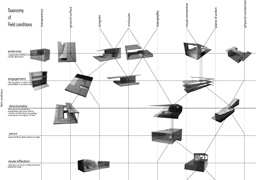|
Unit E 2002-2003 Staff & Visitors
Jonathan Dawes Students
Athanasios Fatsis
|
 Spatial Mechanisms The research of Diploma 3 has focused upon what things do; how we are affected by specific spatial attributes or qualities. Urban Room Initial studies focused upon analysing a specific group of programme types and their urban setting. This collective study revealed a series of spatial fragments that create an ambiguity between what they are and what they do. Taxonomy The notation of effects was developed into a catalogue of differing spatial types. Each potentiality was organized according to their material, visual, programmatic or topological characteristics. NewTown Milton Keynes became the testing ground for intervention. The context of the new town provided an environment for the introduction of another new synthesized urban situation, with a proposed University Campus taking up the remaining block within the central Milton Keynes grid. Collective Master plan A group Master plan yielded every student a programmed parcel as part of the whole. Key strategic objectives, spatial qualities, datums, massing and networks were established and woven into the fabric of each individual design project. Interarticulation Each territory overlapped with its neighbours and forced a negotiation of boundaries. An inter-articulation of spatial agendas became the emergent structuring order of the spaces in-between. |